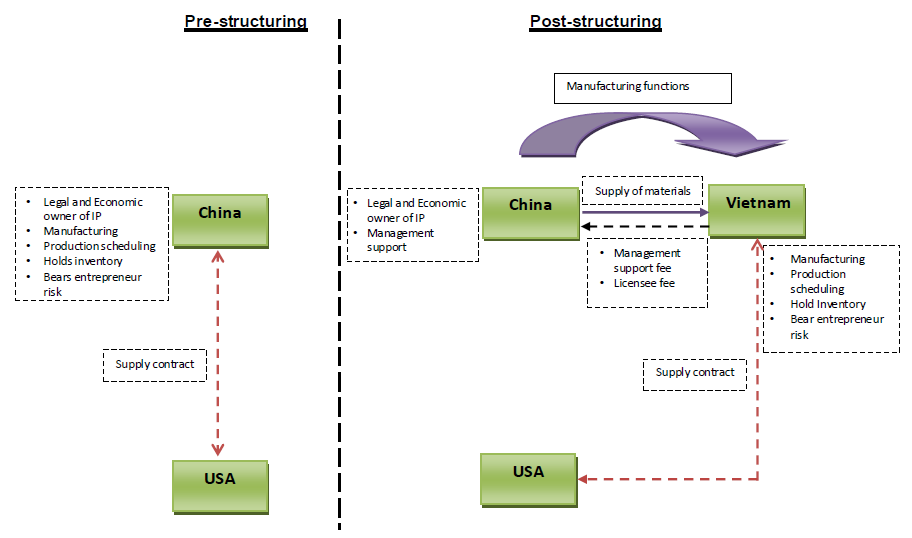-
International Financial Reporting Advisory Services
IFRS reporting advisory serivces of Grant Thornton are carried out by our dedicated team with expertise in IFRS implementation.
-
Audit Services
• Statutory audit • Review of financial statements and financial information • Agreed-upon procedures • FRAS services • Compilation of financial information • Reporting accountant • Cross-border audit • US GAAP audit
-
Audit Quality
We have various methods of monitoring our system of quality control and engagement quality, including real-time involvement of coaches and national office personnel on select audit engagements, reviews of issuer audit engagements prior to archiving by someone outside of the engagement team, and internal inspections of assurance engagements and the system of quality control.
-
Audit Approach
Audit Approach
-
Licensing services
Licensing services
-
International tax planning
Our extensive international network provides us with significant resources to meet all your expansion goals. We strive to develop commercially focused and tailored tax strategies to minimise tax exposures and maximise business efficiency.
-
Expatriate tax planning
We have a broad knowledge base and skills to assist you keep your personal income taxes to a legitimate and reasonable level, while remaining compliant with legislation. We can develop a personalised package for each key employee to take maximum advantage of the exemptions and incentives available.
-
Tax advisory
We will review the proposed business model and transactions and advise on tax implications and recommendations to optimize the tax opportunities under the local regulations and treaties which Vietnam entered into. Furthermore, we coordinate with our GT global tax team to provide a comprehensive tax advisory for the countries involved in the business model and transactions.
-
Tax compliance services
This service is designed to assist enterprises to cope with the statutory tax declaration requirements in line with the Vietnamese tax laws as well as the frequent changes and updates in tax laws.
-
Tax health check
Our Tax Health Check involves a high-level review of specific tax areas to highlight the key issues that need to be rectified in order to reduce tax risks. Through our extensive experience, we have identified key risk areas in which many enterprises are not fully compliant or often overlook potential tax planning opportunities. Our tax health check service represents a cost-effective method to proactively manage risks and reduce potential issues arising as a result of a tax inspection.
-
Transfer Pricing
Transfer pricing is a pervasive tax issue among multinational companies. In Vietnam, the tax authorities require special documentation to report related party transactions. Compliance with transfer pricing regulations is an important aspect of doing business effectively in Vietnam as failure to do so may result in significant penalties.
-
Tax due diligence
We conduct tax due diligence reviews of target companies to analyse their tax exposure and position in relation to acquisitions, mergers or consolidations. We are able to integrate this service with our Advisory Services department in order to offer a comprehensive, holistic due diligence review.
-
Customs and international trade
Our experienced professionals can help you manage customs issues more effectively through valuation planning and making use of available free trade agreements. We also assist Clients in optimising their customs procedures by making use of potential duty exemptions and efficient import-export structures. Risk mitigation activities include customs audit defense and compliance reviews.
-
M&A Transaction
We advise numerous foreign investors on efficient tax structures for their investments. Our experience allows you to consider all the options and set up a corporate structure that meets both operational and tax efficiency requirements. In short, the structure that is best for you.
-
Industrial Zones – Picking A Location For Your Business
Grant Thornton Vietnam’s one-stop services are designed to provide comprehensive support to both new and current investors who are planning to expand or restructure their business in Vietnam. Our professionals have established strong working relationships with landlords, property developers and authorities at various localities. With extensive experiences in liaison with the relevant agencies, we offer assistance including negotiation on land rental rates and efficient management of licensing process. Our customized and flexible solutions can bring benefits of cost efficient location, accelerate licensing process, and optimize tax opportunities while remaining in compliance with legislation.
-
Tax Audit Support
Tax audit support services provide comprehensive assistance to your business in Vietnam. Recent tax practices have shown the general tendency of launching routine tax audit on yearly basis. Tax authorities have been effectively using more sophisticated methods to identify target entities from across different industry sectors.
-
Business Risk Services
Business Risk Services
-
Transaction Advisory Services
Transaction Advisory Services
-
Valuation
Valuation
-
Business consulting services
Finance Management Advisory
-
Accounting services
Accounting services
-
Taxes compliance within outsourcing
Taxes compliance within outsourcing
-
Payroll, personal income tax and labor compliance
Payroll, personal income tax and labor compliance
-
Secondments/Loan staff services
Secondments/Loan staff services
-
Compilation of the financial and non-financial information
Compilation of the financial and non-financial information
-
Accounting systems review and improvement
Accounting systems review and improvement
-
Initial setting-up for accounting and taxes systems
Initial setting-up for accounting and taxes systems
-
Management accounting and analysis
Management accounting and analysis
-
Comprehensive ERP system solution
ERP software is a tool for business operations, production management, order processing and inventory in the business process. Today, ERP software for small and medium businesses has been greatly improved to help businesses manage their business better. The article below will answer all relevant information about what ERP software is and offer the most suitable ERP solution for businesses. Let's follow along!
-
Analyze Business Administration data
We believe in the value that data can bring to the success and development of every business. Our team helps design data architecture supported by tools, to support business governance and provide useful information to management.
-
Financial reporting compliance solution package
Putting financial issues at the heart, this service helps ensure that financial reports for customers comply with both the requirements of Vietnamese accounting regulations and standards (VAS) as well as reporting standards. international finance (IFRS).
-
Third-party ERP extensions
ERP is a long-term solution that requires long-term travel, not short-term. We understand that many businesses cannot deploy the entire ERP system at once due to many different reasons, instead businesses can deploy each part. Over time, these solutions can be expanded to accommodate improved business processes or can even link completely new processes across different departments.
-
Localize, deploy and rebuild the project
Quite a few ERP projects need to be implemented according to current Vietnamese requirements and regulations, but still comply with common international business requirements. These projects need some improvements and adjustments in the right direction.
-
Consulting on technology solutions
We support the selection and implementation of the most suitable solutions, ensuring business efficiency and performance. We will work closely with customers to plan, evaluate and implement the right technology investment strategies and solutions to meet the development needs of businesses.

-
Offshore company establishment service
Using the offshore company model will facilitate the owner in the process of transaction and expand overseas markets, take advantage of the tax policy with many incentives and protect the value of the family enterprise's assets.
-
Private Trust Advisory
The development of the economy with many modern financial instruments has brought many advantages and opportunities for the enterprises, but there are still certain potential risks in any type of business. So how to protect your asset value with an appropriate company structure while stay compliance with relevant regulations?
-
Our values
We have six CLEARR values that underpin our culture and are embedded in everything we do.
-
Learning & development
At Grant Thornton we believe learning and development opportunities help to unlock your potential for growth, allowing you to be at your best every day. And when you are at your best, we are the best at serving our clients
-
Global talent mobility
One of the biggest attractions of a career with Grant Thornton is the opportunity to work on cross-border projects all over the world.
-
Diversity
Diversity helps us meet the demands of a changing world. We value the fact that our people come from all walks of life and that this diversity of experience and perspective makes our organisation stronger as a result.
-
Contact us
Contact us
-
Available positions
Experienced hires
-
Available positions
Available positions
US created ripples in the global trade by levying steep tariffs on trade valuing billions of dollars from various countries including China. Increased tariffs might lead to relocation of global supply chain to escape from the tariffs on Chinese originating goods.
As per the international trade data compiled by US Census for Year 2018, US imported from China around USD 540 billion while it exported only around USD 120 billion, leading to a trade deficit of USD 419 billion. The trade deficit which is an economic measure of international trade indicates that US is net importing country with its trade with China. This has become bone of contention between the two nations.
The Tariff war would prove detrimental to China as it is net exporting country to US trade. The MNCs in USA may try to absorb some of the incremental tariff cost and pass on rest to end consumers. This will increase the cost of doing business for Chinese suppliers in China and may not be sustainable in long term.
The MNCs may explore various economic options to sustain in business. One of the strategies that is widely speculated is shifting of manufacturing base to other countries such as Vietnam, Bangladesh, Myanmar, etc. This would result in permanent business loss for China in favour of other Asian countries.
USA imposed increased tariff on China in sometime early months of 2018, since then lot of traction was observed in Vietnam market. Below is the comparison of US import from Vietnam:
 All figures are in millions of U.S. dollars
All figures are in millions of U.S. dollars
The export from Vietnam to USA has shown a spike by 38.37% which is commendable. Building capacity and infrastructure generally takes time, the ball is in court of business houses and government of Vietnam as to how fast they grab this opportunity.
The increased export not only benefits the exporters based out Vietnam but has cascading effect in the economy. The increased export may have direct impact on the exporters, at the same time it would also impact the economies of other dependent industries such local tool manufacturers, raw material suppliers, hospitality industry, etc. This is a wave which if Vietnam sails through would make it a manufacturing hub of the region.
Shifting of global supply chain
Vietnam has established manufacturing hub and have the required infrastructure, technical resources, low wages and being a neighboring country makes it a natural choice. Therefore, cost of relocation to Vietnam may not be high.
Further, digging down the statistics, available on Office of the United States Trade Representative, below is the major import by USA from China in year ending 2018:

From the above table, it may be construed that the major traction could be observed in electrical machinery and other machinery industry. Looking at the aggressive position adopted by US, the pain may sustain longer or may be permanent as well. This would lead to influx of international transaction between China-Vietnam and Vietnam-USA and have several transfer pricing implications. The typical transaction pre and post structuring in above industry would be as below:

Transfer pricing implication
Transfer pricing is an important issue for MNCs in designing their global supply chains, pricing international transactions and managing their transfer pricing risks. Any such international transactions need to be tested with regards to arm’s length standard. Some of the typical inbound transfer pricing issues with respect to machinery industry that a taxpayer needs to carefully analyze are discussed in subsequent paragraphs.
- Shifting of client contracts
The US is curtailing on any Chinese originating goods, therefore, one of the typical issues from transfer pricing perspective would be shifting of client contracts (i.e. client IP) to Vietnam along with manufacturing base. Going forward the contracts with US parties would be negotiated and entered into by Vietnamese entity. The Chinese tax authority may require that such one-time transfer of client IP should be at Fair Market Value.
Proper due diligence could safeguard taxpayer in justifying that the transaction was neither sham nor tax motivated. Further, commercial rationale needs to be established and that there was no attempt to move profit generating client IP to other jurisdiction under artificial arrangement. It may be imperative to note that such transfer of IP should also have corresponding shift of FAR. In absence of satisfactory documents Vietnamese tax authority may disallow the entire payment for acquiring such IP.
- Purchase of materials
In order to maintain similar quality standards for goods, the Chinese entity may export raw materials, semi-finished goods for manufacturing in Vietnam. The tax payer should prepare proper segmentation segregating between related party and third party business. The segmentation should be based on actuals and in case of common cost pool, on appropriate apportionment basis.
Further, the selection of tested party would play critical role. Vietnamese entity would perform all the major functions pertaining to manufacturing, in contrast, China may perform only functions pertaining to supply of materials. In such scenario, the tested party would be Chinese entity performing simpler functions and Vietnamese entity would be the entrepreneur undertaking relatively complex functions. The taxpayer should maintain the computation of cost details and cost plus markup charged by Chinese entity before it sells to Vietnam. Therefore, comparability analysis undertaking Chinese entity may be more appropriate.
- Licensing of IP
Vietnam typically has the required infrastructure to carry out manufacturing activity but may not have the desired technology, know-how. In such a scenario, China may license its pre-existing IP to Vietnamese entity for manufacturing. The contract would be entered between Vietnam and USA for supply of goods while China may still be benefitted with licensing of technical IP, know-how to Vietnam. This would ideally compensate Chinese entity for some of the business loss.
It would be pertinent to note that, legal ownership of intangibles by Chinese entity alone does not determine entitlement to returns from the exploitation of IP. The entity performing important value creating functions related to development, enhancement, maintenance, protection and exploitation (“DEMPE”), exercise of control can expect corresponding returns. Therefore, the remuneration to Chinese entity would depend on the DEMPE functions performed by it.
The taxpayer needs to document what all manufacturing IPs are there for which payment is being made. Charging a royalty or licensing fee for the use of valuable know-how, technology processes, trade names should be buttressed with cost benefit analysis, evidence test, need test and an independent comparability analysis.
- Management support services
The entity at Vietnam may perform routine manufacturing functions. The Group CEO, CTO and key decision makers may be residing at China who would charge management fee for the supervisory functions it performs. Different type of intra-group services such as Technical, Finance, Accounting, HR, IT, etc would be typically provided within a group by Chinese entity.
The tax authority in Vietnam would be interested in knowing whether the payout commensurate with the benefit derived. Was the services duplicative or was the services really required to perform such functions. Whether such management support enhanced the commercial position of taxpayer. Such management fees need to satisfy the cost benefit test, evidence test, need test etc. If the taxpayer fails to document the above, the entire payment may be disallowed by the tax authority.
- Location Saving
As a result of relocation, MNC is expected to save on typical cost such as labour costs, raw material costs, rent, training costs, infrastructure costs. Location saving is the net cost savings that would be realized by an MNC as a result of relocating manufacturing functions, production, operation sites, etc from a high cost (i.e. China) to low cost (i.e. Vietnam) jurisdiction. The Taxpayer need to document the options realistically available to Chinese entity. The options realistically available, bargaining power of each entity, IPs are key in attributing location saving related return.
Conclusion
Considering, that the current tariff war is going to have far-reaching effect. It is advisable for MNCs to proactively undertake diagnostic review to analyze the impact on supply chain from transfer pricing perspective. Accurate delineation of transactions including contractual terms, the functions of the parties, commercial substance, risks is important. It would also be important to understand whether under an independent scenario a third party would be willing to undertake such transactions. The transactions should be at arm’s length and backed by robust documentation. The remuneration model should be aligned to value creation in the supply chain. For the transaction pertaining to IP, management support robust documentation would play critical role.
However, it would be noteworthy, that merely routing transaction vide Vietnam or putting “Made in Vietnam” tag to avoid tariff sanctions may not be sufficient as US may adopt aggressive positions in such artificial forms lacking commercial substance.









